Office of Science Director Asmeret Asefaw Berhe traveled to key climate science experiments to experience the amazing work the Office is supporting.
December 7, 2023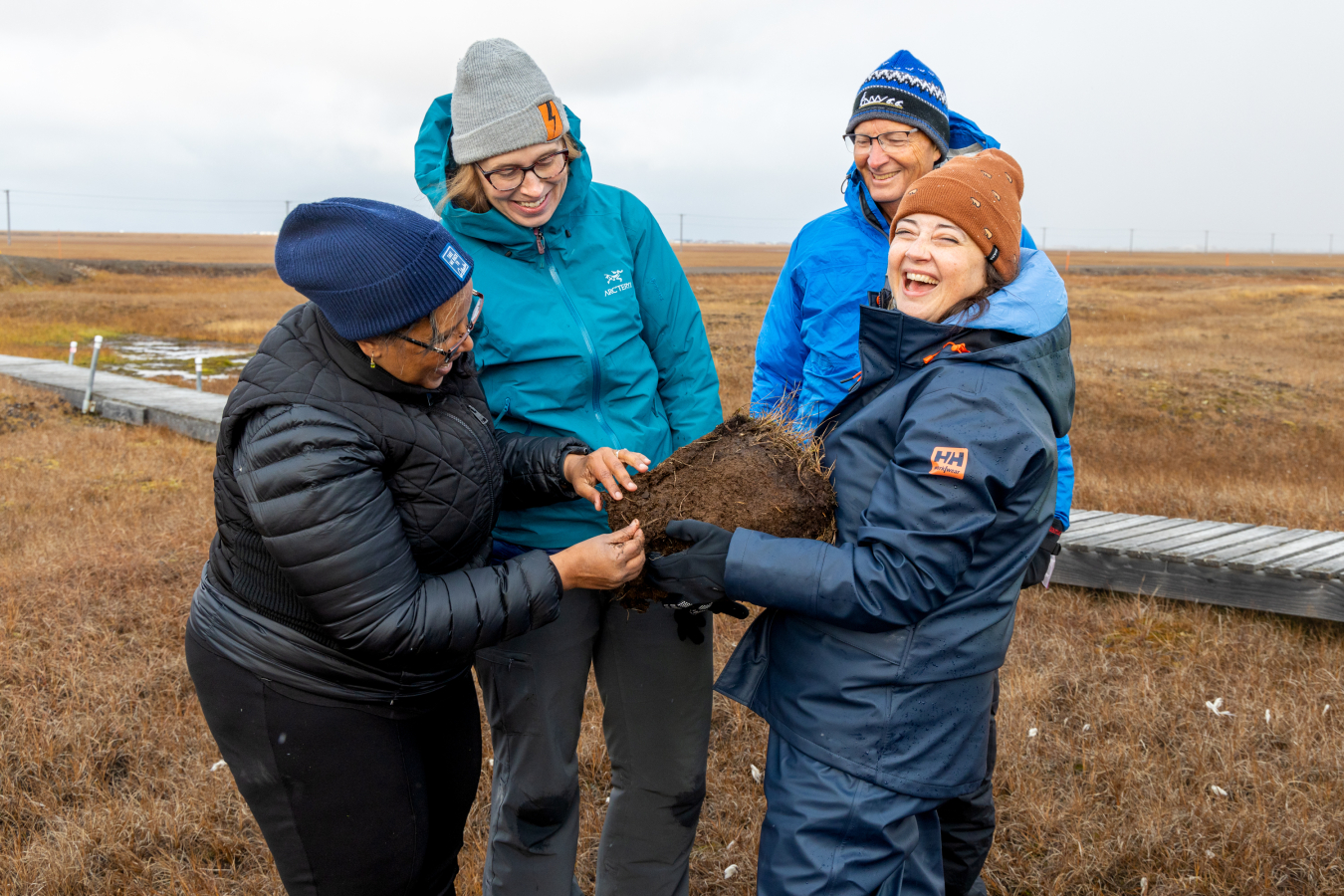
When I joined the Department of Energy’s (DOE) Office of Science as the Director in 2022, I was the first climate scientist to hold this position. As a premier funder of long-term, large-scale climate science, the Office of Science was an ideal place for me to help support key research and highlight the wonderful work DOE-funded scientists are doing. During the 2023 Climate Week (September 18-22), I traveled to Minnesota and Alaska to learn more about the Office of Science’s investments in cutting edge studies of climate.
Some people may wonder why the Office of Science and DOE invest in climate science, but it is no mystery to me. Climate and energy are inextricably linked. Climate affects how our energy systems will operate in the future and how our energy systems are the main contributor to climate change. The Office of Science has also been supporting the most advanced Earth system models for decades for long-term predictions of climate. These models must be informed and validated by real environments.
I got to visit three key experiments funded by the Office of Science’s Biological and Environmental Research Program: Spruce and Peatland Responses Under Changing Environments (SPRUCE project), the Snow ALbedo eVOlution (SALVO) experiment at the Atmospheric Radiation Measurement (ARM) facility, and the Next-Generation Ecosystem Experiments (NGEE) Arctic. These experiments are each vital in their own right. But combined together, they have given us insight into how humans impact the environment and what we can expect in the future. All three experiments are either led by or have heavy involvement from DOE’s national laboratories. From soil science to microbiology to hydrogeology, the national laboratories bring new insights to scientific disciplines and sustain long-term experiments with world class instrumentation, personnel, and safety culture.
For the Alaska portion of my trip, I was joined by the Director of the DOE Arctic Energy Office, Erin Whitney, and several of her top advisors. The Arctic Energy Office leads work on the administration's and DOE’s domestic energy Administration priorities as well as cross-cutting opportunities and priorities in the Arctic region. Traveling through Alaska, it was clear to me why the Arctic Energy Office is essential. Their expertise and connections to the local communities were invaluable and helped make my trip a success!
Day 1: Monday, September 18, Grand Rapids, Minnesota
We started our trip in Northern Minnesota with an experiment among the trees. The Spruce and Peatland Responses Under Changing Environments (SPRUCE) project is located in the peatland bogs of the Marcell Experimental Forest. In the cool, crisp weather with sunshine poking through the trees, we walked along metal boardwalks past greenhouse-like structures. Each structure is an experiment in progress. Inside each one, there is a mix of different temperatures and carbon dioxide levels. These mini-ecosystems allow scientists to study the impact of climate change and the resulting atmosphere on the environment. The scientists study the effects on the soils, microbes, subsurface water, plants, and more. The alien-like pods look like topless greenhouses, each one either circulating carbon dioxide, heating the air and subsurface, both, or neither (the vital control pod). The most extreme pod is 9 degrees hotter than the air outside with an elevated carbon dioxide concentration. The plaque above the door to the pod says, “Welcome to a warmer future.” It’s a stark reminder of the potential future of Earth under a changing climate.
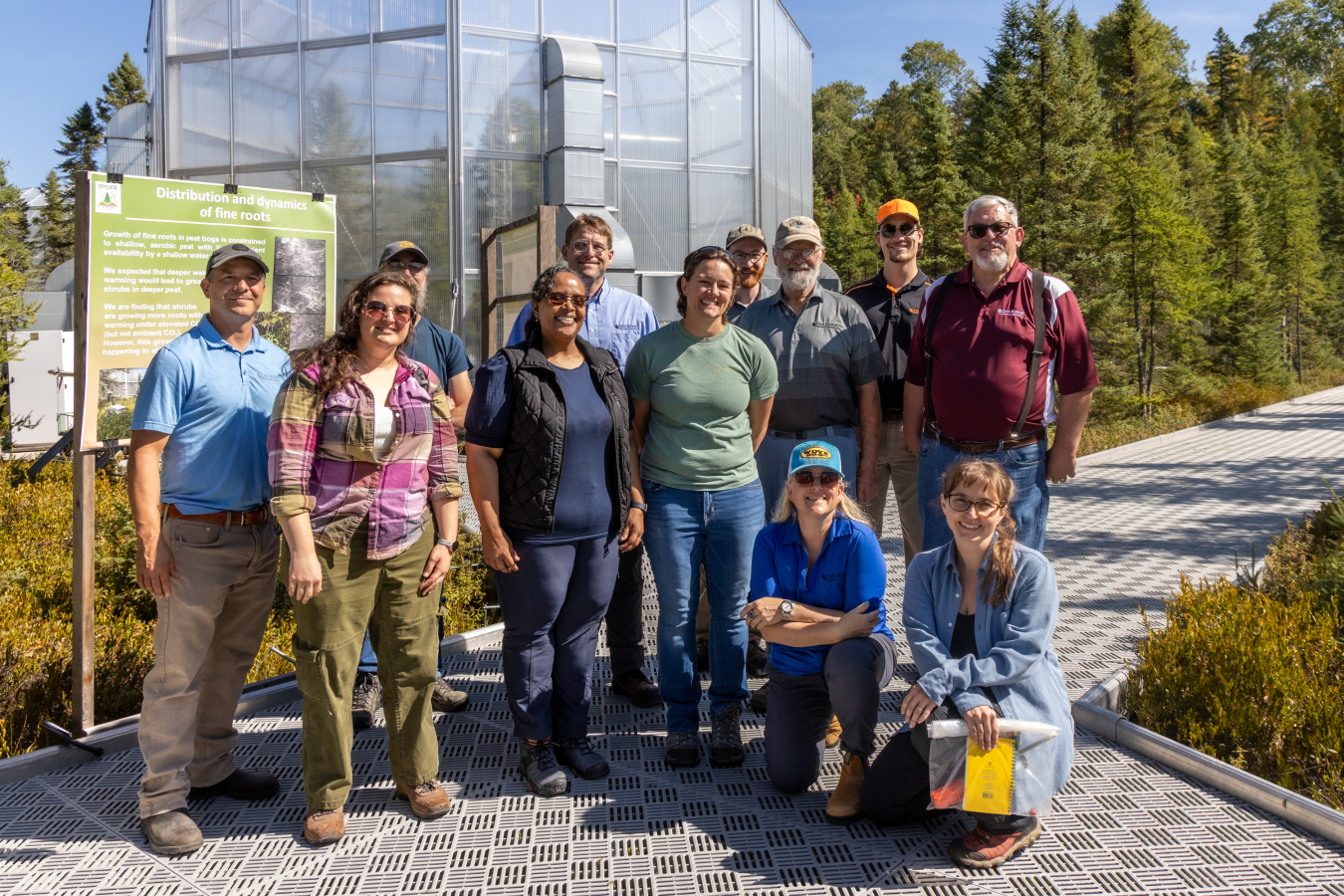
As a soil scientist, I know this is an important environment to study. Peatland-bogs are not well represented in Earth system models. While they cover only 3% of the Earth’s land surface, they store about 30% of the land’s carbon. Peat is a carbon-rich soil. As the team extracts a soil core for me to experience up close, I revel in the rich, dark color and moisture content. It’s about 3 feet from the top layers of the plant- and root-rich soil to the peat. Touching and seeing this large sample of soil that is rich with organic material and so vital to the ecosystem was my favorite activity of the day.
The SPRUCE project is run by the DOE’s Oak Ridge National Laboratory in partnership with universities and the U.S. Department of Agriculture (USDA) Forest Service. This decadal project is building off the long history of Forest Service research at the site. We have learned so much from this interagency collaboration over the lifetime of this experiment.
One of the most fascinating things the scientists have discovered has to do with the spongy moss, ubiquitous in the bog undergrowth. Stepping off the boardwalk, we experienced sinking into hills of moss. It was almost like sinking into sand, but with the spring of a trampoline. The SPRUCE experiments have found that, in warming scenarios, this moss is struggling to survive. These dense layers of moss contain a lot of stored carbon which will be released into the atmosphere when they decompose, a potential feedback loop to climate change. For more fascinating scientific insights we have gleaned from this amazing experiment, listen to the scientists themselves on The Sound of Science SPRUCE podcast episode!
Day 2: Tuesday, September 19, Utqiaġvik, AK
On day 2 of our trip, we woke up bright and early to embark on a full day of travel, all the way to the top of Alaska. Utqiaġvik (formerly Barrow), Alaska, is sometimes referred to as the “top of the world.” It’s a remote village in Arctic Alaska, with colorful houses and unpaved roads. As we landed in the small airport, locals unloaded bins of goods purchased in Anchorage. Because there are no roads connecting the town to the rest of Alaska, the only way to reach Utqiaġvik is by plane or barge. That makes household goods, like toilet paper and food staples, very expensive. The same goes for energy resources. The city has electric power, but any replacement parts for the grid or alternative power systems are expensive to acquire. It’s especially important in this location where winters are dark and brutal (the average December temperature is negative 18 degrees Fahrenheit) to keep people’s homes warm and bright. It’s an important place for DOE to provide support to help this community maintain their quality of life as we transition to a carbon-free grid.
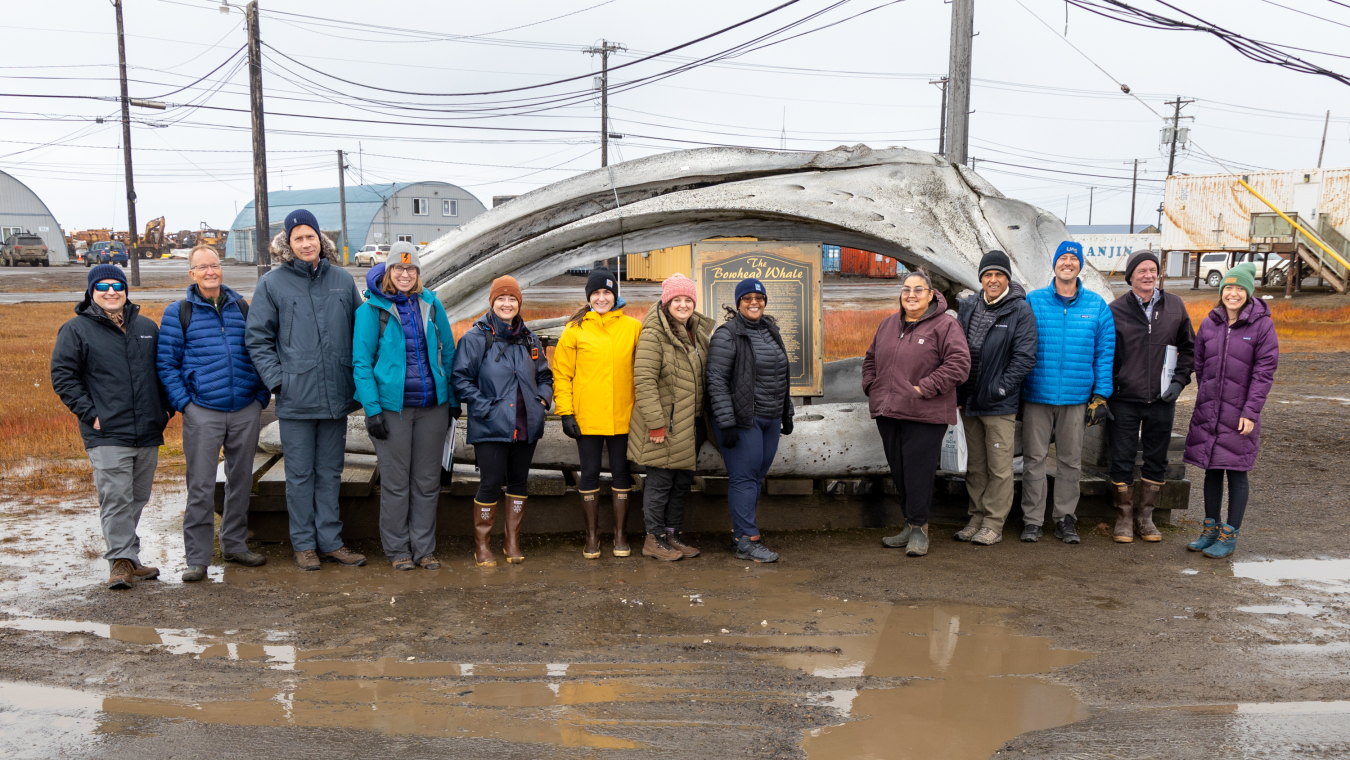
The locals we talked with in Utqiaġvik support this mission. Many of the locals, the majority of whom are Iñupiat – Alaskan Natives – have a special connection to the land where their ancestors have resided. This community has seen and felt the impacts of climate change as their shores are eroding, ice sheets are disappearing quicker, and permafrost is melting. In fact, during our trip, heavy rains caused one of the major roads to flood. We witnessed empty containers placed at the shore to prevent it from being washed away. As this community disproportionately feels the impact of climate change, they need continued support to ensure their perspectives are represented in scientific research about the changing landscape. My office, the Office of Science, is helping to do just that.
Throughout my time in Utqiaġvik, I met with members of the community. They ranged from radio hosts (shout out to KBRW) to community leaders to faculty and staff at Iḷisaġvik College, Alaska’s only Tribal college. I also met with the local Alaskan Native Corporation, the Ukpeaġvik Iñupiat Corporation (UIC). The community was warm and welcoming and so supportive of the important science we do. Alaska and the surrounding Arctic is a vast place. DOE is able to complete research in Utqiaġvik because of the 7,400 acres of private land for scientific research that UIC set aside in 1992. In addition, their company, UIC Science, provides a wide variety of logistical services to Arctic research projects based out of Utqiaġvik. Without the support of the community, our experiments in Alaska cannot be successful.
Day 3: Wednesday, September 20, Utqiaġvik, AK
We began our Alaska adventure ready to learn about all the amazing research DOE scientists are doing. But before we visited any of the research sites, we had a discussion on safety. All the scientists must go through a safety briefing before heading out into the field. As the site is in a remote wilderness with wild animals and harsh weather conditions, it’s important to check in with everyone’s physical and mental health as well as identify potential hazards. DOE’s research teams have a safety-first culture that is vital for working in any environment, especially the Arctic. After these important discussions, we were ready for our first outing, a visit to the North Slope of Alaska (NSA) site, part of the Atmospheric Radiation Measurement (ARM) user facility.
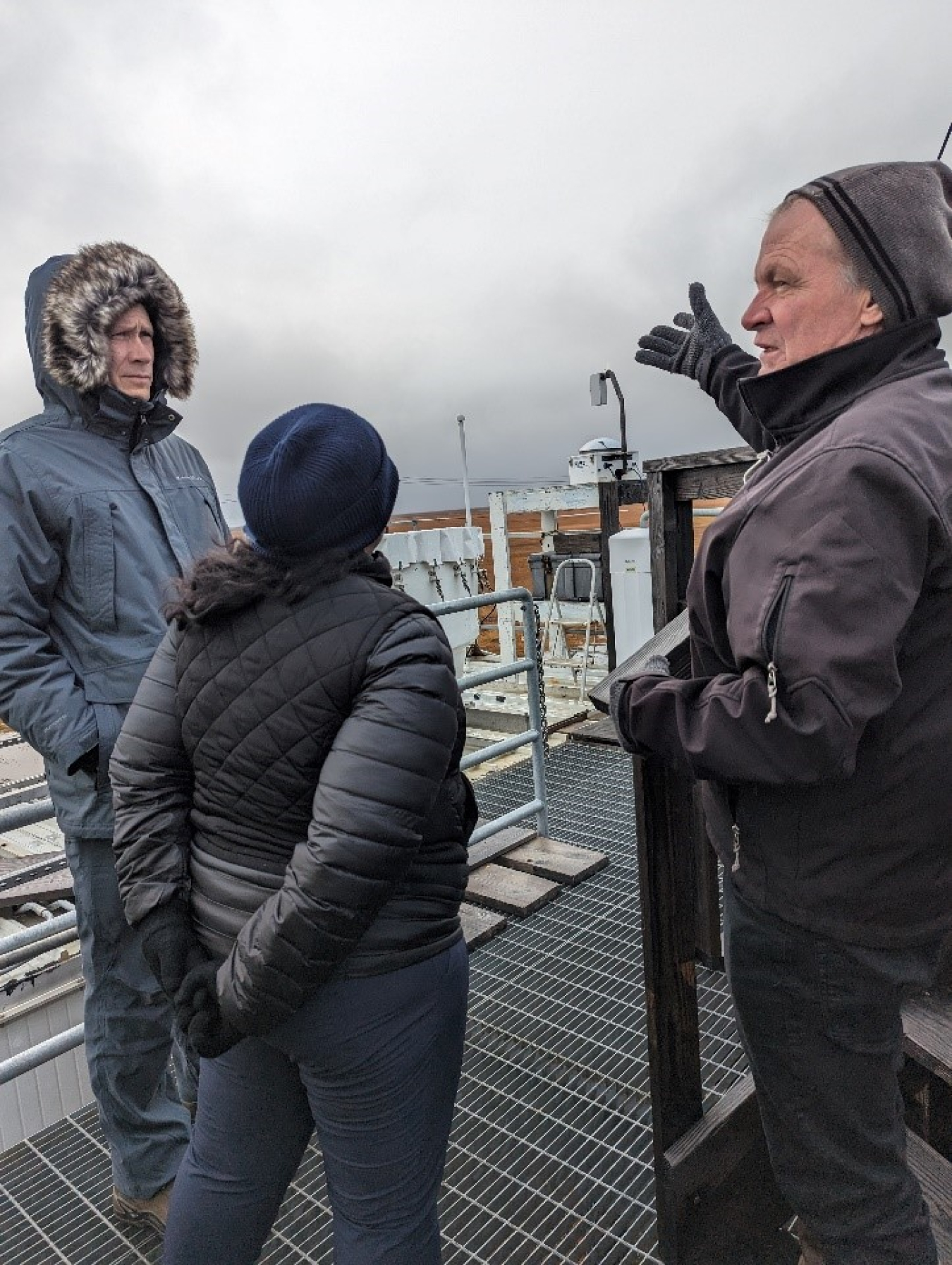
The NSA site conducts atmospheric and ecological research and measurements in the Arctic. It is one of several ARM observatories around the world, both fixed and mobile, that conduct atmospheric and solar radiation measurements. The ARM NSA observatory, run by DOE’s Sandia National Laboratories, has hosted research near the coast of the Arctic Ocean for over 20 years. As a user facility site, scientists around the world can propose experiments to complete at the facility, and if their proposal gets chosen, use the facility free of charge. Our first stop is the ARM bunkhouse, where the longtime local father and son technicians have their offices. There are also comfortable facilities for research scientists to live in when completing their research.
Finally, we get the chance to see the site in person! We made our way out onto the tundra and climbed up the stairs to the roof where the instruments are mounted to measure comprehensive data about cloud and radiative processes at high latitudes. There were no trees to shelter us as the wind and rain whipped around the group. One of the experiments we learned about is the Snow ALbedo eVOlution (SALVO) field campaign. This experiment measures the amount of sunlight the ground reflects compared to the amount of incoming solar radiation, or albedo. Researchers measure the landscape during all seasons. From snow-covered landscape to brown tundra, the albedo is drastically affected by the variation of the ground surface. As the Arctic is warming more quickly than anywhere else on the planet, it is important for DOE’s cutting edge Earth system models to accurately take albedo into effect.
Day 4: Thursday, September 21, Utqiaġvik, AK
On our final day in Alaska, we were able to visit another key climate experiment in the Arctic, the Next-Generation Ecosystem Experiments Arctic (NGEE Arctic). NGEE Arctic is a joint experiment between the University of Alaska at Fairbanks and four national laboratories: Oak Ridge National Laboratory, Los Alamos National Laboratory, Lawrence Berkeley National Laboratory, and Brookhaven National Laboratory. This team has been measuring the impacts of a warming climate on the tundra ecosystem since 2012. Understanding the tundra ecosystem is key for a predictive understanding of the carbon-rich Arctic system. One of scientists’ main questions about this ecosystem is how the melting permafrost will impact the climate. Permafrost is the layer of soil in the Arctic that is permanently frozen, all year round. It has been frozen for up to thousands of years, which has prevented the carbon-rich material it contains from breaking down. There are many unanswered questions for how the melting permafrost will affect the surrounding environment.
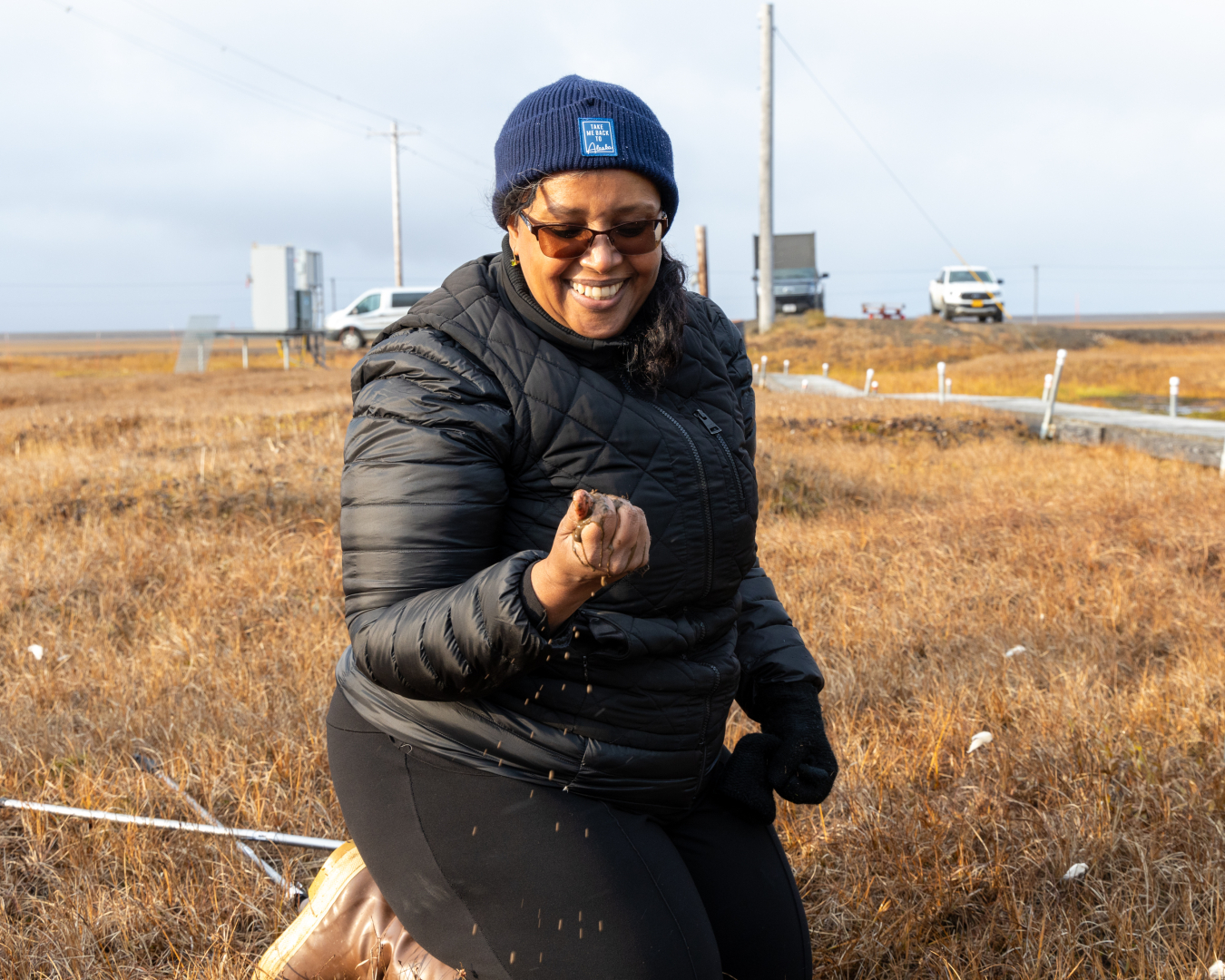
As we walked out onto the wooden boardwalks, sometimes through ponds of meltwater, we could just make out the polygons on the land surface. These are a distinctive feature of the tundra landscape caused by the frequent freeze/thaw cycles. The vegetation hugged the ground to avoid the harsh elements around it. As it started to snow, we stepped out onto the tundra surface. There, the research team showed us a block of soil they extracted to show the complex layers of roots and soils. The roots penetrate the soil, acquiring the resources the plants need. In some cases, these plants store five times more mass below ground than above. I held the soil to my chest and breathed in (you may have heard of tree huggers, but I firmly classify myself as a soil hugger). The team then let me kneel on the ground to insert my entire arm into the now empty hole, reaching down to touch the permafrost below. The ice below was not only cold, but completely solid. If I tried hitting it, I think my whole hand would have shattered. Despite my expertise, there was so much going on below my feet that I didn’t know about. The researchers have devoted years of their career to this region, as they discuss in the Sound of Science podcast, “The Unseen World of Climate Change.” The team is finishing up their decade-long data collection in the tundra in Utqiaġvik. Next, they are planning on using what they have learned here to test and validate their models in different Arctic environments.
Heading Home
As we packed up to head home, I reflected on how all three experiments work together to give us insight into two essential ecosystems: peatland bogs and Arctic tundra. Both are key environments to understand how climate change is affecting our world. All these experiments will better inform our Earth system models to predict how changing climates will affect people and communities, like the one I got to know in Utqiaġvik. The success is bittersweet. While there are new challenges to address, it is also the end of our research in the community of Utqiaġvik. I am thankful that they regret seeing us go as opposed to rejoicing over our absence.
Although these are my observations of the experiments, they’re shaped by the insightful people we met and talked with, the community we learned from, and the scientists who guided us along the way. I am forever thankful for their time and dedication.

